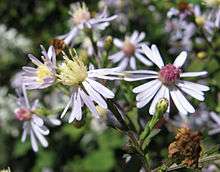Symphyotrichum cordifolium
| Symphyotrichum cordifolium | |
|---|---|
 | |
| Heartleaf Aster | |
| Scientific classification | |
| Kingdom: | Plantae |
| (unranked): | Angiosperms |
| (unranked): | Eudicots |
| (unranked): | Asterids |
| Order: | Asterales |
| Family: | Asteraceae |
| Subfamily: | Asteroideae |
| Tribe: | Astereae |
| Genus: | Symphyotrichum |
| Species: | S. cordifolium |
| Binomial name | |
| Symphyotrichum cordifolium (L.) G.L.Nesom | |
| Synonyms | |
|
Aster cordifolius L. | |
Symphyotrichum cordifolium, syn. Aster cordifolius (common names common blue wood aster,[3] blue wood-aster[4] or heartleaf aster), is a species of flowering plant in the family Asteraceae, native to eastern North America. An herbaceous perennial, it can be readily found along forest edges and in open areas, as well in urban areas and in cultivation. It sometimes produces a naturally occurring hybrid with S. puniceum named Symphyotrichum × tardiflorum where their ranges overlap. The composite flowers, which typically have bluish to rarely white ray florets and light yellow disc florets that eventually turn purple, emerge in August and persist into October.
Distribution and habitat
Symphyotrichum cordifolium is present in a wide area, from Manitoba in the north west, east to Nova Scotia and Maine, south to Georgia and Alabama and west to Oklahoma. It grows primarily in mesic sites with soils that are rocky to loamy, but generally rich, at heights ranging from sea level along the coastal plain up to 1,200 m (3,937 ft) in the Appalachians. It can be found on open wooded slopes, along the banks of streams, on moist ledges, in swampy woods, along the borders of beech-maple and oak-hickory forests, as well as in clearings, thickets and along roadsides and ditches. It can also be found in urban areas where it is occasionally encountered as a weed species.[5]
Cultivation
This is a tough plant which can cope with neglect. It is particularly valued for supplying late summer, autumn and even winter flower colour in the garden, in shades of blue, pink and white.[6] Still widely referenced under its former name Aster cordifolius particularly in the British Isles, it shows strong similarities to plants in the genus Aster. Several cultivars have been selected for garden use, of which the following have achieved the Royal Horticultural Society's Award of Garden Merit:-
- A. cordifolius 'Sweet lavender'[7]
- A. cordifolius 'Chieftain'[8]
- 'Little Carlow' (A. cordifolius hybrid)[9]
References
- ↑ "Symphyotrichum cordifolium". NatureServe Explorer. NatureServe. Retrieved 2007-06-15.
- ↑ International Organization for Plant Information (IOPI). "Plant Name Search Results" (HTML). International Plant Names Index. Retrieved 2008-06-07.
- 1 2 "Symphyotrichum cordifolium". Natural Resources Conservation Service PLANTS Database. USDA. Retrieved 6 December 2015.
- ↑ "BSBI List 2007". Botanical Society of Britain and Ireland. Archived from the original (xls) on 2015-02-25. Retrieved 2014-10-17.
- ↑ Brouillet, Luc; Semple, John C.; Allen, Geraldine A.; Chambers, Kenton L.; Sundberg, Scott D. (2006). Flora of North America Editorial Committee, eds. 1993+, ed. "Flora of North America". 20. New York & Oxford: Oxford University Press: 501.
|contribution=ignored (help) - ↑ http://www.telegraph.co.uk/gardening/3324244/Blazin-squad.html
- ↑ "RHS Plant Selector - Aster cordifolius 'Sweet Lavender'". Retrieved 6 June 2013.
- ↑ "RHS Plant Selector - Aster cordifolius 'Chieftain'". Retrieved 6 June 2013.
- ↑ "RHS Plant Selector - Aster 'Little Carlow'". Retrieved 6 June 2013.
| Wikimedia Commons has media related to Symphyotrichum cordifolium. |
| Wikispecies has information related to: Symphyotrichum cordifolium |

.png)

